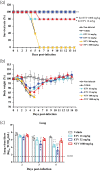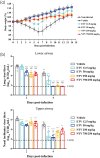Efficacy comparison of 3CL protease inhibitors ensitrelvir and nirmatrelvir against SARS-CoV-2 in vitro and in vivo
- PMID: 36760083
- PMCID: PMC10068418
- DOI: 10.1093/jac/dkad027
Efficacy comparison of 3CL protease inhibitors ensitrelvir and nirmatrelvir against SARS-CoV-2 in vitro and in vivo
Abstract
Objectives: Severe acute respiratory syndrome coronavirus 2 (SARS-CoV-2) has become established in the human population, making the need to develop safe and effective treatments critical. We have developed the small-molecule antiviral ensitrelvir, which targets the 3C-like (3CL) protease of SARS-CoV-2. This study evaluated the in vitro and in vivo efficacy of ensitrelvir compared with that of another SARS-CoV-2 3CL PI, nirmatrelvir.
Methods: Cultured cells, BALB/cAJcl mice and Syrian hamsters were infected with various SARS-CoV-2 strains, including the ancestral strain WK-521, mouse-adapted SARS-CoV-2 (MA-P10) strain, Delta strain and Omicron strain. Ensitrelvir efficacy was compared with that of nirmatrelvir. Effective concentrations were determined in vitro based on virus-induced cytopathic effects, viral titres and RNA levels. Lung viral titres, nasal turbinate titres, body-weight changes, and animal survival were also monitored.
Results: Ensitrelvir and nirmatrelvir showed comparable antiviral activity in multiple cell lines. Both ensitrelvir and nirmatrelvir reduced virus levels in the lungs of mice and the nasal turbinates and lungs of hamsters. However, ensitrelvir demonstrated comparable or better in vivo efficacy than that of nirmatrelvir when present at similar or slightly lower unbound-drug plasma concentrations.
Conclusions: Direct in vitro and in vivo efficacy comparisons of 3CL PIs revealed that ensitrelvir demonstrated comparable in vitro efficacy to that of nirmatrelvir in cell culture and exhibited equal to or greater in vivo efficacy in terms of unbound-drug plasma concentration in both animal models evaluated. The results suggest that ensitrelvir may become an important resource for treating individuals infected with SARS-CoV-2.
© The Author(s) 2023. Published by Oxford University Press on behalf of British Society for Antimicrobial Chemotherapy.
Figures


Similar articles
-
Efficacy of ensitrelvir against SARS-CoV-2 in a delayed-treatment mouse model.J Antimicrob Chemother. 2022 Oct 28;77(11):2984-2991. doi: 10.1093/jac/dkac257. J Antimicrob Chemother. 2022. PMID: 35914182 Free PMC article.
-
Oral 3CL protease inhibitor ensitrelvir suppressed SARS-CoV-2 shedding and infection in a hamster aerosol transmission model.Antiviral Res. 2024 Dec;232:106026. doi: 10.1016/j.antiviral.2024.106026. Epub 2024 Oct 29. Antiviral Res. 2024. PMID: 39477094
-
Ensitrelvir is effective against SARS-CoV-2 3CL protease mutants circulating globally.Biochem Biophys Res Commun. 2023 Feb 19;645:132-136. doi: 10.1016/j.bbrc.2023.01.040. Epub 2023 Jan 14. Biochem Biophys Res Commun. 2023. PMID: 36689809 Free PMC article.
-
[Nirmatrelvir plus ritonavir (Paxlovid) a potent SARS-CoV-2 3CLpro protease inhibitor combination].Rev Esp Quimioter. 2022 Jun;35(3):236-240. doi: 10.37201/req/002.2022. Epub 2022 Feb 21. Rev Esp Quimioter. 2022. PMID: 35183067 Free PMC article. Review. Spanish.
-
Ensitrelvir as a novel treatment option for mild-to-moderate COVID-19: a narrative literature review.Ther Adv Infect Dis. 2025 Apr 11;12:20499361251321724. doi: 10.1177/20499361251321724. eCollection 2025 Jan-Dec. Ther Adv Infect Dis. 2025. PMID: 40292087 Free PMC article. Review.
Cited by
-
Ensitrelvir Fumaric Acid: First Approval.Drugs. 2024 Jun;84(6):721-728. doi: 10.1007/s40265-024-02039-y. Epub 2024 May 25. Drugs. 2024. PMID: 38795314 Review.
-
SARS-CoV-2 resistance to monoclonal antibodies and small-molecule drugs.Cell Chem Biol. 2024 Apr 18;31(4):632-657. doi: 10.1016/j.chembiol.2024.03.008. Cell Chem Biol. 2024. PMID: 38640902 Free PMC article. Review.
-
Effect of Renal Impairment on Pharmacokinetics and Safety of Ensitrelvir, a SARS-CoV-2 3CL Protease Inhibitor.Infect Dis Ther. 2024 Mar;13(3):597-607. doi: 10.1007/s40121-024-00946-x. Epub 2024 Mar 9. Infect Dis Ther. 2024. PMID: 38460082 Free PMC article.
-
Sporadic Occurrence of Ensitrelvir-Resistant SARS-CoV-2, Japan.Emerg Infect Dis. 2024 Jun;30(6):1289-1291. doi: 10.3201/eid3006.240023. Epub 2024 Apr 26. Emerg Infect Dis. 2024. PMID: 38669127 Free PMC article.
-
Modeling the Impact of Ensitrelvir on SARS-CoV-2 Dynamics and Its Application for Assessment of Transmission Mitigation of Patients with COVID-19.Infect Dis Ther. 2024 Nov;13(11):2377-2393. doi: 10.1007/s40121-024-01046-6. Epub 2024 Oct 7. Infect Dis Ther. 2024. PMID: 39373863 Free PMC article.
References
Publication types
MeSH terms
Substances
LinkOut - more resources
Full Text Sources
Medical
Research Materials
Miscellaneous

